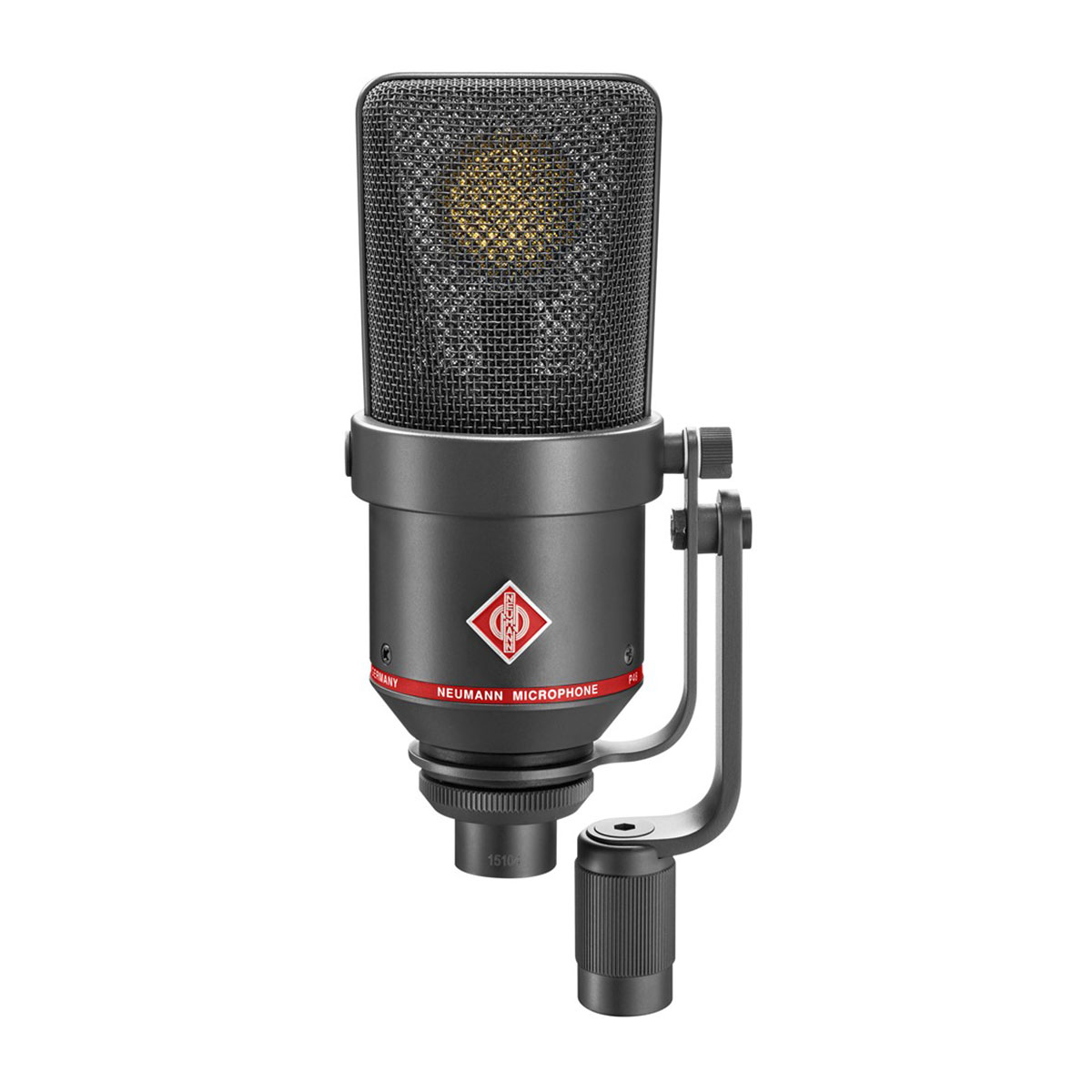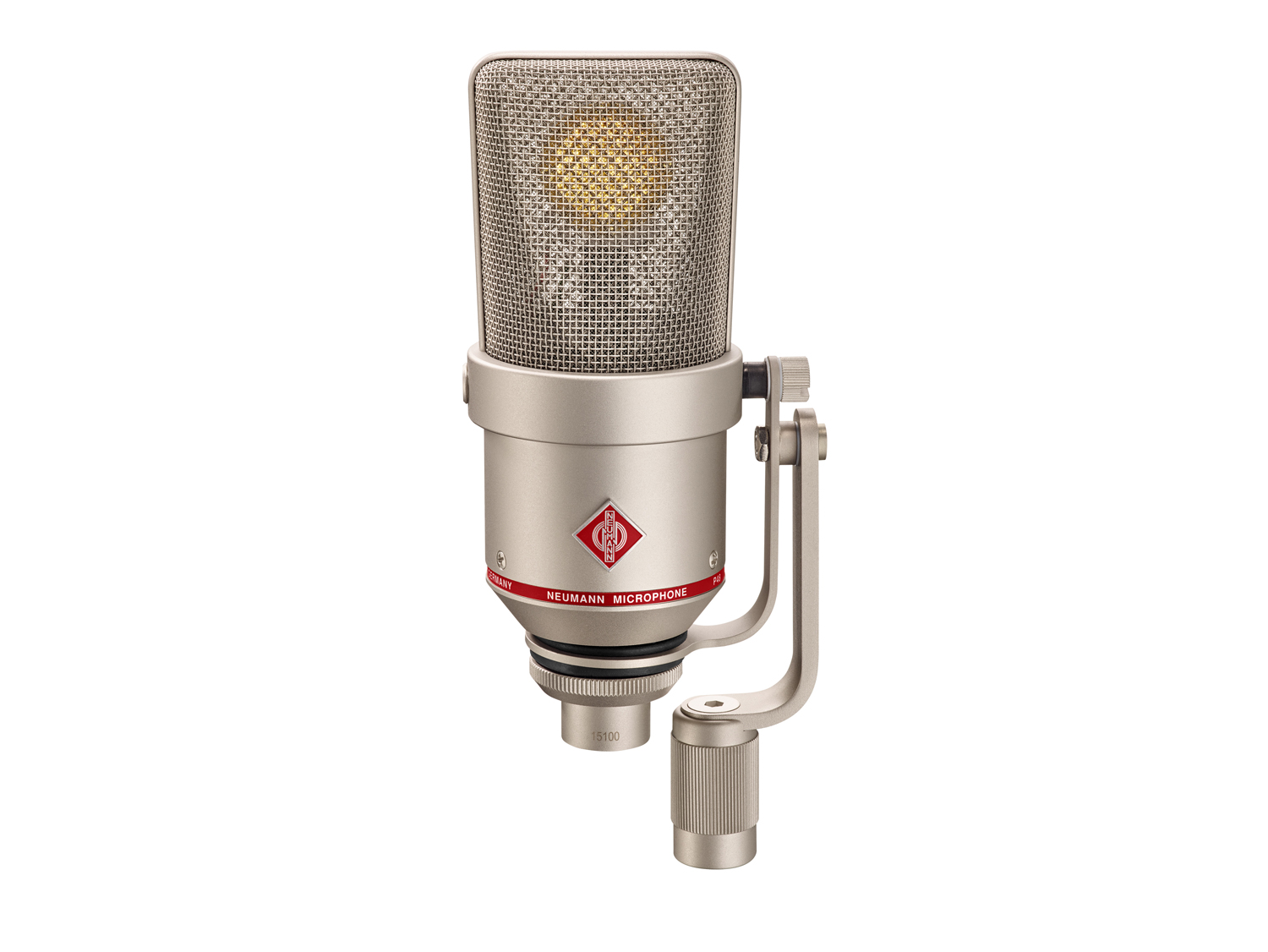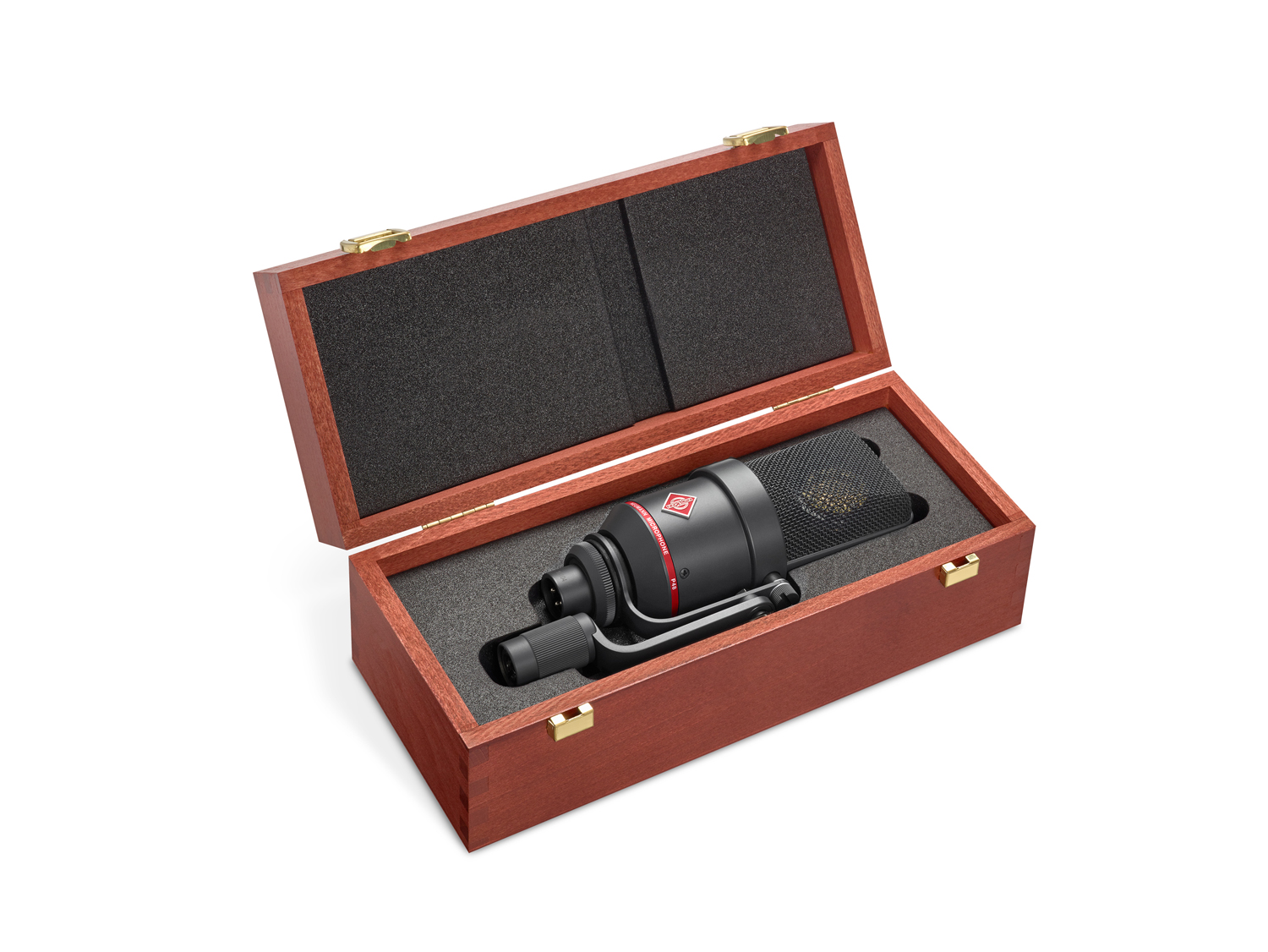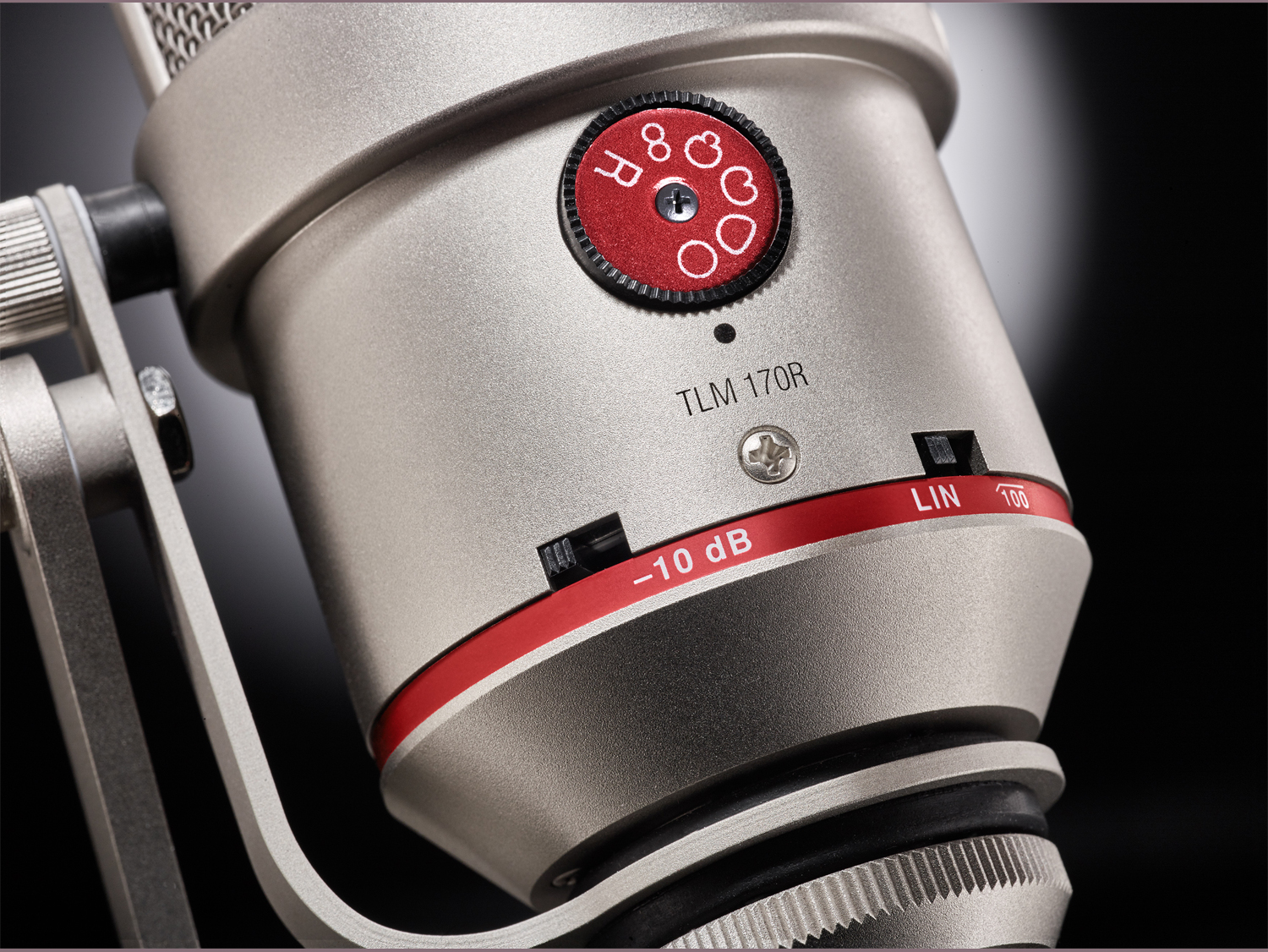Neumann TLM 170R Condenser Microphone
The Neumann TLM 170R is a large diaphragm, studio condenser microphone with 5 polar patterns selected either by a rotary switch on the rear side of the microphone, or remotely by the N 48 R-2 dual phantom power supply / controller, (optional). “TLM” stands for Trans-formerless Microphone. The “R” denotes remote control capability. Remote control of microphone polar patterns had previously been achieved only through the use of special, multi-conductor cables and connectors. The Neumann TLM 170R is the first microphone to achieve this feat via standard, two conductor shielded microphone cable and 3-pin XLR type connectors.
When using the rotary switch on the rear of the body of the microphone to select the polar patterns, the Neumann TLM 170R will function normally with any 48V phantom power source conforming to DIN 45 596. For remote control of the polar pattern, the “r” position is selected and the N 48R-2 is required. The N 48 R-2 will provide phantom power and independent polar pattern control for two microphones. Remote control is affected by varying the phantom power voltage in 1.5V increments from 45-51 volts.
The mic comes equipped with a swivel shock-mount providing effective isolation from external mechanical vibrations. It may be easily removed or mounted on the opposite side of the microphone when required. An optional elastic suspension EA 170 is also available.
The TLM 170R is distinguished from previous Neumann TLM 170 by a red ring around the base of the microphone body. Two finishes are available: satin nickel, (silver) and matte black. Previous TLM 170 can be upgraded for remote control via circuit modification.
Features of the Neumann TLM 170R Condenser Microphone
- Local and remote controlled large diaphragm microphone
- Pressure-gradient transducer with double membrane capsule
- Five directional characteristics: omni, wide angle cardioid, cardioid, hypercardioid, figure-8
- Patented circuitry for remote and local switching of directional characteristics
- Switchable low frequency roll-off and 10 dB preattenuation
TLM 170R Applications
The Neumann TLM 170 R condenser microphone is a large diaphragm microphone with multiple polar patterns. Its sound has a very transparent characteristic, in contrast to some of our other microphones that have a distinct personality.
Therefore, this microphone is used for many diverse applications in professional recording studios, in broadcasting, film and television, and for semiprofessional productions. The polar patterns can be selected either at the microphone itself, or controlled remotely through the special N 248 power supply.
TLM 170R Acoustic features
The microphone is addressed from the front, marked with the Neumann logo. The large diaphragm capsule inside the headgrille has a very smooth frequency response for all polar patterns over a wide acceptance angle. The curves are flat and parallel to the 0° frequency curve up to 10 kHz within an angle of ± 100°.
As a result the Neumann TLM 170 R has a very even diffuse-field response for all polar patterns. This is important in a reverberant environment, as more reflections arrive at the microphone from different directions. The acoustic information is not affected in its tonal quality when recorded by the microphone. This characteristic is achieved without resorting to corrective resonance effects.
Therefore, the microphone maintains an excellent impulse response reproducing all transient phenomena of music and speech without any coloration. The capsule is elastically mounted to avoid any structure borne noise that could interfere with its operation.
TLM 170R Polar patterns
In addition to the usual directional polar patterns: omnidirectional, cardioid, and figure-8, we have added a hypercardioid and wide-angle cardioid characteristic. When compared to the standard cardioid pattern, the hypercardioid characteristic suppresses sound from the side more efficiently. The wide-angle polar pattern is especially useful to record large sound sources.
Remote control
The N 248 controls the polar pattern remotely by varying the phantom voltage. The range is ± 3 V of the nominal 48 V value. (According to DIN standard a range of ± 4 V is permissible.)
The rotary switch on the microphone must be in the position R (= remote control). In this switch position the Neumann TLM 170 R microphone analyses the absolute value of the phantom power and selects the corresponding polar pattern. A standard 3-pin microphone cable is used, similar to the microphone’s conventional operation. Cable lengths may be up to 300 m (1000 feet).
Electrical features
The letters TLM stand for “transformerless microphone”. With TLM technology the usual output transformer is replaced by an electronic circuit. As with traditional transformers, it ensures good common mode rejection, and prevents RF interference, that may influence the balanced audio signal.
Use on tripods
The Neumann TLM 170 R is provided with a tilting side bracket to attach the microphone to booms or stands. The bracket is equipped with rubber elements that effectively protect the microphone from mechanical shock. If necessary, it can be mounted on the other side of the microphone as well.
When using the IC 4 cable (for example to suspend the microphone from the ceiling with the MNV 87 auditorium hanger), the bracket and its holder need to be removed. The microphone can then be connected to the swivel mount connector of the cable.
Filter and attenuation
The TLM 170 R microphone has a 10 dB attenuation switch to prevent the input of the following unit from being overloaded. A second switch at the rear allows to attenuate the frequency response below 100 Hz to suppress undesired structure borne noise.
Operational safety
All exposed surfaces of the capsule, including the diaphragms, are at ground potential. This technology makes them highly immune to electrical and atmospheric interference and contamination through dust particles.
Available in Nickel or Black. Please specify at checkout.
What’s in the box
- TLM 170 R Microphone
- Dust Cover
- Wooden Box
Specifications
- Acoustical operating principle: Pressure gradient transducer
- Directional pattern: Omnidirectional, wide angle cardioid, cardioid, hypercardioid, figure-8
- Frequency range: 20 Hz … 20 kHz
- Sensitivity at 1 kHz into 1 kohm: 8 mV/Pa
- Rated impedance: 50 ohms
- Rated load impedance: 1 kohms
- Equivalent noise level, CCIR1): 26 dB
- Equivalent noise level, A-weighted1): 14 dB-A
- Signal-to-noise ratio, CCIR1) (rel. 94 dB SPL): 68 dB
- Signal-to-noise ratio, A-weighted1) (rel. 94 dB SPL): 80 dB
- Maximum SPL for THD 0.5%2): 144 dB
- Maximum SPL for THD 0.5% with preattenuation2): 154 dB
- Maximum output voltage: 10 dBu
- Supply voltage (P48, IEC 61938): 48 V ± 4 V
- Current consumption (P48, IEC 61938): 3 mA
- Matching connector: XLR3F
- Weight: 625 g
- Diameter: 60 mm
- Length: 152 mm
- 1) according to IEC 60268-1; CCIR-weighting acccording to CCIR 468-3, quasi peak; A-weighting according to IEC 61672-1, RMS
- 2) measured as equivalent el. input signal





